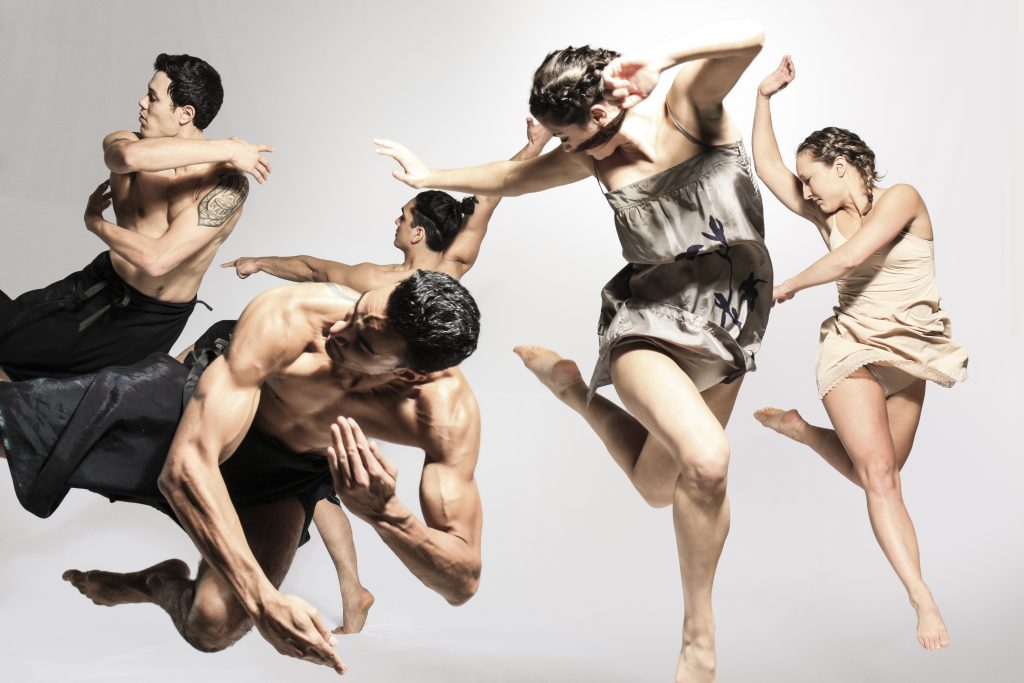Black Grace: Conjuring exquisite dances from ancient bones
Calling someone black in Neil Ieremia’s New Zealand neighborhood meant they were daring and brave, though few men connected with the word grace. He combined the words to name his dance company Black Grace, which conjured exquisite modern dances from ancient bones at the Spreckels Theatre April 8.

Black Grace celebrates Pacific, Maori, and New Zealand culture. Image courtesy LJMS
Ieremia is Samoan and his choreography fuses contemporary, hip-hop, and haka, an ancient Maori war dance known for its intense foot stomping and full-voiced shouting.
The program of five dances, presented by La Jolla Music Society, opened with Minoi, a vigorous work based on a Samoan nursery rhyme. Yet this was a powerful, masculine dance.
A line of bare-chested men mesmerized with ah-lu-ee-loy vocalizations. Deep and overlapping, they chanted like monks.
Each time they stretched into deep second position with muscled legs, viewers had to breathe along with them.
The excitement kept building as they snapped fingers, clapped hands, and stamped feet. They became drum machines and lighting by Mark Burlace moved our focus from group to soloist.
When Black Grace exploded onto New Zealand stages in 1995, they were an all-male troupe of Pacific Islander and Maori men. Today, women offer welcome balance and outstanding technique.
Women dressed in sundresses scooped and grabbed the air with cupped hands, as if grabbing a pesky fly in Pati Pati, a ritual dance with traditional Pacific vocabulary. The men joined to evoke alternating pistons of a machine. Three rose up, three pulsed downward. Lighting turned red and golden, and the playful clap-stomping kept chugging until the lights faded. The dance created the illusion of dancers traveling into a sunset, and the crowd loved it.
Black Grace has evolved from a group of Ieremia’s friends into New Zealand’s treasured dance troupe. His new work, Crying Men – Excerpt (premiere 2017), explored the challenges and expectations for “real men,” beyond playing rugby.
A man appeared near the stage edge in a pool of light until a howling sound sent chills and forced him to hide in darkness. To our left, a man struggled to carry another man who fell and contorted at his feet, foreshadowing a heartfelt dance of pain and death, war and loss. There were moments when we could hear the men singing, “Looking for whales,” which cast a lost at sea narrative.
Ieremia’s vocabulary is intensely athletic, yet graceful. It is rare to witness a troupe of men and women so physically fit and turned out at the same time. Black Grace sold out at Jacobs Pillow Festival more than 10 years ago, and has been touring internationally ever since.
They are dance rock stars in New Zealand. Mother Mother was originally choreographed for a music video for the band Fat Freddy’s Drop. It’s a tribute to Ieremia’s mother who reminds him to be humble and grateful.
The score was jazzy and limbs were angular. Women and men broke into twos and threes against a black background and dry ice added a city street vibe. They ran and rolled and hopped over each other, and their leaps into hip-hop forms were a thrilling mash up of old and new.
A woman in fringy white flew again and again into the arms of her friends, and tumbled downward, a controlled fall similar to a ballet fish dive. YouTube can’t compare with watching the troupe live, but give it a go.
The La Jolla Music Society crowd likes to mingle and sip wine at shows, and this one offered a long intermission before the finale set to Vivaldi and The Lord’s Prayer, in Samoan.
Side lights illuminated dancers kicking and spinning in the 40 minute work As Night Falls – Abridged. They were always running across the stage left and right to leave a trio behind, as seen in many ballets. In joyful fashion, they slapped their behinds and spiraled to the ground. Travel trunks served as the backdrop. Costumes were gauzy blue and at times the dancers moved like little trains chugging backwards.
Ieremia says his process began with dark news stories, broken bodies and natural disasters. But he was determined to create some light from the darkness. He succeeded, especially in weaves, low rolls, and daring tosses.
In program notes he describes a structure like the layout of a broadsheet newspaper. One can imagine the squiggles, patterns, and imagery of his early notes.
Dancers of Black Grace are commanding performers with fascinating hard-to-spell names.
They moved with precision and heart, and while the movement was contemporary and daring, they channeled the ancients.
Dancers climbed onto each other and arched backward into supporting arms without fear. They linked arms across shoulders. As drums rumbled, they took turns to show off in the center, which is a shared tradition.
They were a family, a tribe, a community. They charged forward into an invisible wall, got knocked to the ground, but kept walking forward. As the sound of violins filled the theater, they repeated their last step ball changes and we shared their joy.
Presented by La Jolla Music Society. Dance Series. http://ljms.org/directory/listing/program-black-grace
San Diegans experienced South Pacific dance last year at the International Fringe Festival. I wrote about 1918, presented by Moana of New Zealand.

Kris Eitland covers dance and theater for Sandiegostory.com and freelances for other publications, including the Union Tribune and Dance Teacher Magazine. She grew up performing many dance styles and continued intensive modern dance and choreography at the Univ. of Minnesota, Duluth, and San Diego State Univ. She also holds a journalism degree from SDSU. Her career includes stints in commercial and public radio news production.
Eitland has won numerous Excellence in Journalism awards for criticism and reporting from the San Diego Press Club. She has served on the Press Club board since 2011 and is a past president. She is a co-founder of Sandiegostory.com. She has a passion for the arts, throwing parties with dancing and singing, and cruising the Pacific in her family’s vintage trawler. She trains dogs, skis, and loves seasonal trips to her home state of Minnesota.
